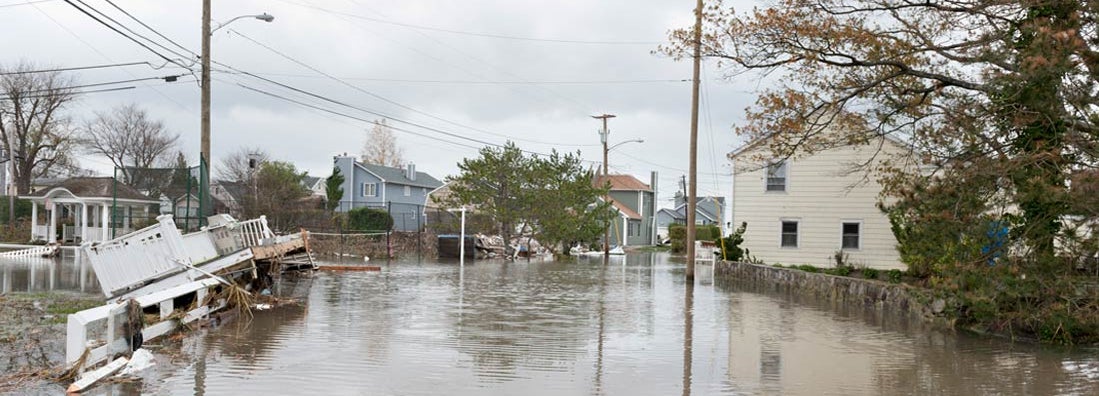Flood Insurance in Vermont
Experts break down flood insurance costs, coverage and companies in Vermont.

Jeff Green has held a variety of sales and management roles at life insurance companies, Wall street firms, and distribution organizations over his 40-year career. He was previously Finra 7,24,66 registered and held life insurance licenses in multiple states. He is a graduate of Stony Brook University.

Vermont is small in size, which makes it very dangerous when a severe storm or extreme flooding hits the state. In the past, $63 million in insurance claims were made from just one flood event. No matter where you live in the state, you could be at risk of flood damage, which is why you need to make sure you have flood insurance that will help you recover from a catastrophic event.
Flood insurance is offered through the government, but can also be purchased from a private carrier. A local independent insurance agent can help you understand your options and secure a policy that best fits your needs and your budget.
What Is Flood Insurance?
Flood insurance is a type of coverage that helps you recover from floodwaters by paying for damage to your personal property and the structure of your home. Flood coverage is not included in your Vermont homeowners insurance policy, which is why you need to purchase a separate policy.
Flood insurance only covers damage from natural waters, which in Vermont can mean everything from rain or snowmelt to rising rivers and levee failures.
What Does Flood Insurance Cover in Vermont?
The main things that are covered by your flood insurance are the structure of your home and the stuff inside your home. Through building and contents coverage your policy protects items like:
- Windows
- Plumbing
- Walls
- Ceilings
- Electrical
- Appliances
- Furniture
- Electronics
Coverage will also include debris removal, floodproofing costs, loss avoidance measures, and coverage for your condominium or apartment. Your flood insurance policy will have a comprehensive list of exactly what is covered and not covered.
If you purchase flood insurance through the National Flood Insurance Program, it will include coverage up to $250,000 for the building and $100,000 for the building contents. If you are choosing insurance through a private carrier, you'll want to work with your independent insurance agent to determine the proper limits.
What Isn't Included in Flood Insurance in Vermont?
There are several exclusions in flood insurance that are important to know. It won't cover any water damage not caused by natural waters. This includes damage from burst pipes, a leaky second-floor tub, or something similar. It also will not cover damage from an earthquake or mudslide.
Additional exclusions exist for what will be covered in your basement or below the lowest-level floor. Typically, any washers and dryers, food freezers, and portable air conditioners that are located on this level will not be covered.
Lastly, the amount of water plays a major factor in whether flood insurance will cover damage. Most policies specify that the flood water must cover at least two acres of normally dry land in order to qualify for reimbursement. Your agent can walk you through the exclusions in your specific policy.
Do You Need Flood Insurance in Vermont?
Vermont doesn't top the news for areas that are in danger of flooding, but historically there have been floods reported in nearly every part of the state. Currently, more than 45,000 properties have a 26% or greater chance of experiencing flooding within the next 30 years.
For some property owners, flood insurance will be required. If your home is located in a high-risk flood zone, you'll be federally obligated to have flood insurance. Even in non-risk areas, a mortgage lender may require flood coverage in order to provide you with a loan.
Keep in mind that 20% of flood insurance claims come from homeowners in moderate- to low-risk areas, so even if it's not required, it's worthwhile to assess your risk and determine if a policy is right for you.
What Flood Zones Require Flood Insurance in Vermont?
The only zones in Vermont that require flood insurance are high-risk zones. The Federal Emergency Management Agency (FEMA) has broken down flood zones into three general categories: high-risk, moderate- to low-risk, and undetermined.
- High-risk flood zones: These zones are labeled with the letter A or V on the FEMA maps. These zones have the highest risk of flooding. Insurance is required in high-risk zones.
- Moderate to low-risk zones: These zones are labeled with the letters B, C, or X on the FEMA maps. While flood risk is reduced in these zones, it is not completely removed. Insurance is recommended in these zones.
- Undetermined flood zones: These zones are labeled with the letter D on the FEMA maps. In these areas, flood risks have not been determined but may still be present.
You can use the FEMA Flood Map Service Center to see which zone your home is located in.
How Much Does Flood Insurance Cost in Vermont?
Flood insurance is surprisingly expensive in Vermont compared to the national average for coverage. In fact, Vermont is the most expensive state for flood insurance. Premiums are 106% higher than the national average.
- Flood insurance premiums in Vermont: $1,512 a year
Because of the increased costs, it's important to work with an independent insurance agent to shop flood insurance quotes in Vermont. Agents will be able to compare coverage from the NFIP to private coverage and ensure that you're getting the most affordable policy. One benefit of purchasing a policy from the NFIP is that the prices are regulated and your rates do not increase if you have to file a claim.
What are the Best Flood Insurance Companies in Vermont?
Even though it's a small state, Vermont has a variety of options when it comes to insurance carriers that offer flood insurance. Whether you're going with a private carrier or the NFIP, shopping flood insurance quotes in Vermont can help you save money.
Knowing which carrier offers the best customer experience alongside a reliable policy can be difficult to nail down. Local independent insurance agents have built a network of trusted carriers to work with across the state. They'll shop flood insurance quotes for you and can steer you in the direction of the best flood insurance companies in Vermont.
Why Shop Flood Insurance with a Vermont Independent Insurance Agent?
If you plan on purchasing flood insurance through the government, you need to go through a qualified insurance provider. Even if you're thinking private carrier, you'll want the insight of a local expert such as an independent insurance agent.
An agent will speak with you, free of charge, to learn about your needs and discuss the risks of your home for flooding. They'll get an understanding of the value of your property and assets and then shop flood insurance quotes to offer you. Agents can answer your questions, guide you to purchasing a good policy, and assist you in the claims process if you need to file. Work with an agent today to find the best flood insurance in Vermont.
https://www.fema.gov/press-release/20210318/fact-sheet-flood-plain-management-insurance-and-rebuilding-0
https://msc.fema.gov/portal/home
https://www.floodsmart.gov/understanding-my-flood-zone
https://www.floodsmart.gov/policy-terms
https://floodfactor.com/state/vermont/50_fsid
https://floodready.vermont.gov/flood_costs
https://www.weather.gov/safety/flood-states-vt
